关键词:RISC-V 开发板、RVB2601、WiFi&BLE,低功耗,玄铁 E906,AliOS Things,RISC-V MCU,上手 好用,控制,开关
1. 前言
基于 RVB2601 的 GUI 程序是利用 Lvgl 开源组件实现在 OLED 屏幕上的字符和图形显示。开发者可以利用 Lvgl 组件在 OLED 屏幕上实现 Label 控件显示功能。
建议在看本文之前,先详细看下RVB2601资源。本例程名为 ch2601_gui_demo,可以通过 CDK 直接从 OCC 拉取。
2. 硬件配置
2.1 显示屏
RVB2601 开发板采用的是 OLED 显示屏, 位于开发板正面。
2.2 屏幕物理接口
CH2601 开发板采用单彩色图形显示面板,屏幕分辨率 128x64 pixel,屏幕背景颜色可选,该程序中采用的是一块黄色背景的屏幕。屏幕控制器采用 SSD1309,通过 4 wire SPI 接口与主芯片连接, 原理图如下所示, 对应的 pin 引脚分别为 PA27、PA28、PA29、PA30。 原理图如下:
软件通过对 SPI 进行读写操作来实现对 OLED 屏上的像素进行点操作,从而实现整个屏的点亮操作。
3. GUI 软件开发
3.1 LVGL 介绍
LVGL 全称 Light and Versatile Graphics Library,是一个自由的,开源的 GUI 库,具有界面精美,资源消耗小,可移植度高, 响应式布局等特点, 全库采用纯 c 语言开发.
主要特性如下.
具有非常丰富的内置控件,像 buttons, charts, lists, sliders, images 等
高级图形效果:动画,反锯齿,透明度,平滑滚动
支持多种输入设备,像 touchpad, mouse, keyboard, encoder 等
支持多语言的 UTF-8 编码
支持多个和多种显示设备,例如同步显示在多个彩色屏或单色屏上
完全自定制的图形元素
硬件独立于任何微控制器或显示器
可以缩小到最小内存 (64 kB Flash, 16 kB RAM)
支持操作系统、外部储存和 GPU(非必须)
仅仅单个帧缓冲设备就可以呈现高级视觉特效
使用 C 编写以获得最大兼容性(兼容 C++)
支持 PC 模拟器
为加速 GUI 设计,提供教程,案例和主题,支持响应式布局
提供了在线和离线文档
基于自由和开源的 MIT 协议
支持 MicroPython
3.2 例程下载
打开 CDK,点击 HOME 图标,查找 ch2601_gui_demo 后,打开工程可以看到以下目录:
3.3 LVGL 移植接口
Lvgl 移植代码位于 app/src/lvgl_porting 文件夹内,其包含 oled.c 和 oled.h。
以下功能接口位于 app/src/lvgl_porting/oled.c, 实现 SPI 管脚的初始化,主要针对 CS, DATA, CLOCK, DATAIN 管脚,同时实现了对不同管脚的读写操作。
static void oled_gpio_init(){ // csi_gpio_pin_init(&pin_clk, PA28); csi_gpio_pin_dir(&pin_clk, GPIO_DIRECTION_OUTPUT); csi_gpio_pin_init(&pin_mosi, PA29); csi_gpio_pin_dir(&pin_mosi, GPIO_DIRECTION_OUTPUT); csi_gpio_pin_init(&pin_cs, PA27); csi_gpio_pin_dir(&pin_cs, GPIO_DIRECTION_OUTPUT); csi_gpio_pin_init(&pin_miso, PA30); //dc csi_gpio_pin_dir(&pin_miso, GPIO_DIRECTION_OUTPUT);}static void lcd_cs(uint8_t d){ if (d == 1) { csi_gpio_pin_write(&pin_cs, GPIO_PIN_HIGH); } else { csi_gpio_pin_write(&pin_cs, GPIO_PIN_LOW); }}static void lcd_dc(uint8_t d){ if (d == 1) { csi_gpio_pin_write(&pin_miso, GPIO_PIN_HIGH); } else { csi_gpio_pin_write(&pin_miso, GPIO_PIN_LOW); }}static void lcd_sclk(uint8_t d){ if (d == 1) { csi_gpio_pin_write(&pin_clk, GPIO_PIN_HIGH); } else { csi_gpio_pin_write(&pin_clk, GPIO_PIN_LOW); }}static void lcd_sdin(uint8_t d){ if (d == 1) { csi_gpio_pin_write(&pin_mosi, GPIO_PIN_HIGH); } else { csi_gpio_pin_write(&pin_mosi, GPIO_PIN_LOW); }}
复制代码
void Write_Command(unsigned char Data){ unsigned char i; lcd_cs(0); lcd_dc(0); for (i = 0; i < 8; i++) { lcd_sclk(0); lcd_sdin((Data & 0x80) >> 7); Data = Data << 1; lcd_sclk(1); } lcd_dc(1); lcd_cs(1);}void Write_Data(unsigned char Data){ unsigned char i; lcd_cs(0); lcd_dc(1); for (i = 0; i < 8; i++) { lcd_sclk(0); lcd_sdin((Data & 0x80) >> 7); Data = Data << 1; lcd_sclk(1); } lcd_dc(1); lcd_cs(1);}
复制代码
void Set_Start_Column(unsigned char d){ Write_Command(0x00 + d % 16); // Set Lower Column Start Address for Page Addressing Mode // Default => 0x00 Write_Command(0x10 + d / 16); // Set Higher Column Start Address for Page Addressing Mode // Default => 0x10}void Set_Addressing_Mode(unsigned char d){ Write_Command(0x20); // Set Memory Addressing Mode Write_Command(d); // Default => 0x02 // 0x00 => Horizontal Addressing Mode // 0x01 => Vertical Addressing Mode // 0x02 => Page Addressing Mode}void Set_Column_Address(unsigned char a, unsigned char b){ Write_Command(0x21); // Set Column Address Write_Command(a); // Default => 0x00 (Column Start Address) Write_Command(b); // Default => 0x7F (Column End Address)}void Set_Page_Address(unsigned char a, unsigned char b){ Write_Command(0x22); // Set Page Address Write_Command(a); // Default => 0x00 (Page Start Address) Write_Command(b); // Default => 0x07 (Page End Address)}void Set_Start_Line(unsigned char d){ Write_Command(0x40 | d); // Set Display Start Line // Default => 0x40 (0x00)}void Set_Contrast_Control(unsigned char d){ Write_Command(0x81); // Set Contrast Control for Bank 0 Write_Command(d); // Default => 0x7F}void Set_Segment_Remap(unsigned char d){ Write_Command(d); // Set Segment Re-Map // Default => 0xA0 // 0xA0 => Column Address 0 Mapped to SEG0 // 0xA1 => Column Address 0 Mapped to SEG127}void Set_Entire_Display(unsigned char d){ Write_Command(d); // Set Entire Display On / Off // Default => 0xA4 // 0xA4 => Normal Display // 0xA5 => Entire Display On}void Set_Inverse_Display(unsigned char d){ Write_Command(d); // Set Inverse Display On/Off // Default => 0xA6 // 0xA6 => Normal Display // 0xA7 => Inverse Display On}void Set_Multiplex_Ratio(unsigned char d){ Write_Command(0xA8); // Set Multiplex Ratio Write_Command(d); // Default => 0x3F (1/64 Duty)}void Set_Display_On_Off(unsigned char d){ Write_Command(d); // Set Display On/Off // Default => 0xAE // 0xAE => Display Off // 0xAF => Display On}void Set_Start_Page(unsigned char d){ Write_Command(0xB0 | d); // Set Page Start Address for Page Addressing Mode // Default => 0xB0 (0x00)}void Set_Common_Remap(unsigned char d){ Write_Command(d); // Set COM Output Scan Direction // Default => 0xC0 // 0xC0 => Scan from COM0 to 63 // 0xC8 => Scan from COM63 to 0}void Set_Display_Offset(unsigned char d){ Write_Command(0xD3); // Set Display Offset Write_Command(d); // Default => 0x00}void Set_Display_Clock(unsigned char d){ Write_Command(0xD5); // Set Display Clock Divide Ratio / Oscillator Frequency Write_Command(d); // Default => 0x70 // D[3:0] => Display Clock Divider // D[7:4] => Oscillator Frequency}void Set_Low_Power(unsigned char d){ Write_Command(0xD8); // Set Low Power Display Mode Write_Command(d); // Default => 0x04 (Normal Power Mode)}void Set_Precharge_Period(unsigned char d){ Write_Command(0xD9); // Set Pre-Charge Period Write_Command(d); // Default => 0x22 (2 Display Clocks [Phase 2] / 2 Display Clocks [Phase 1]) // D[3:0] => Phase 1 Period in 1~15 Display Clocks // D[7:4] => Phase 2 Period in 1~15 Display Clocks}void Set_Common_Config(unsigned char d){ Write_Command(0xDA); // Set COM Pins Hardware Configuration Write_Command(d); // Default => 0x12 // Alternative COM Pin Configuration // Disable COM Left/Right Re-Map}void Set_NOP(){ Write_Command(0xE3); // Command for No Operation}void Set_Command_Lock(unsigned char d){ Write_Command(0xFD); // Set Command Lock Write_Command(d); // Default => 0x12 // 0x12 => Driver IC interface is unlocked from entering command. // 0x16 => All Commands are locked except 0xFD.}
复制代码
static void oled_initialize(){ Set_Command_Lock(0x12); // Unlock Driver IC (0x12/0x16) Set_Display_On_Off(0xAE); // Display Off (0xAE/0xAF) Set_Display_Clock(0xA0); // Set Clock as 116 Frames/Sec Set_Multiplex_Ratio(0x3F); // 1/64 Duty (0x0F~0x3F) Set_Display_Offset(0x00); // Shift Mapping RAM Counter (0x00~0x3F) Set_Start_Line(0x00); // Set Mapping RAM Display Start Line (0x00~0x3F) Set_Low_Power(0x04); // Set Normal Power Mode (0x04/0x05) Set_Addressing_Mode(0x02); // Set Page Addressing Mode (0x00/0x01/0x02) Set_Segment_Remap(0xA1); // Set SEG/Column Mapping (0xA0/0xA1) Set_Common_Remap(0xC8); // Set COM/Row Scan Direction (0xC0/0xC8) Set_Common_Config(0x12); // Set Alternative Configuration (0x02/0x12) Set_Contrast_Control(Brightness); // Set SEG Output Current Set_Precharge_Period(0x82); // Set Pre-Charge as 8 Clocks & Discharge as 2 Clocks Set_VCOMH(0x34); // Set VCOM Deselect Level Set_Entire_Display(0xA4); // Disable Entire Display On (0xA4/0xA5) Set_Inverse_Display(0xA6); // Disable Inverse Display On (0xA6/0xA7) Fill_RAM(0x00); // Clear Screen Set_Display_On_Off(0xAF); // Display On (0xAE/0xAF)}
复制代码
static void gui_label_create(void){ lv_obj_t *p = lv_label_create(lv_scr_act(), NULL); lv_label_set_long_mode(p, LV_LABEL_LONG_BREAK); lv_label_set_align(p, LV_LABEL_ALIGN_CENTER); lv_obj_set_pos(p, 0, 4); lv_obj_set_size(p, 128, 60); lv_label_set_text(p, "THEAD RISC-V\nGUI\nDEMO");}
复制代码
3.4. 编译运行
编译通过后,点击下载,下载成功后复位运行。可看屏上显示"THEAD RISC-V\nGUI\nDEMO" 字符串。
4. 总结
本例程介绍了如何通过 SPI 接口来实现对 OLED 屏幕的图形显示。后续还有更多的开发例程,敬请期待!
本文转自平头哥芯片开放社区(occ),更多详情请点击https://occ.t-head.cn/store/board?channelName=1。
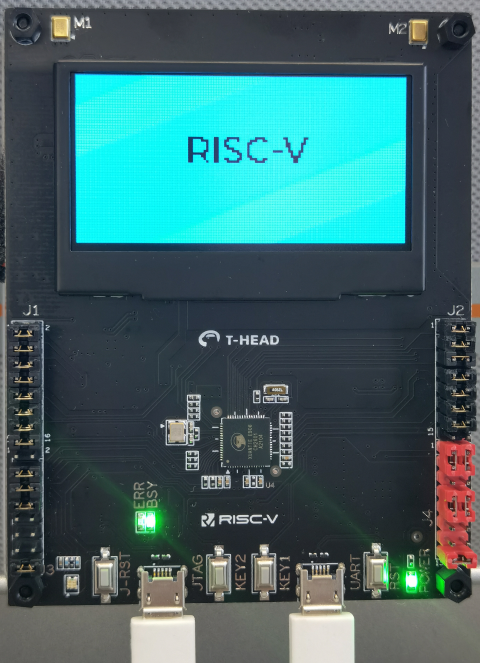

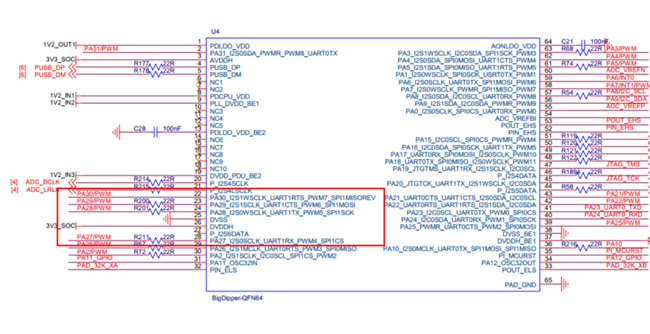
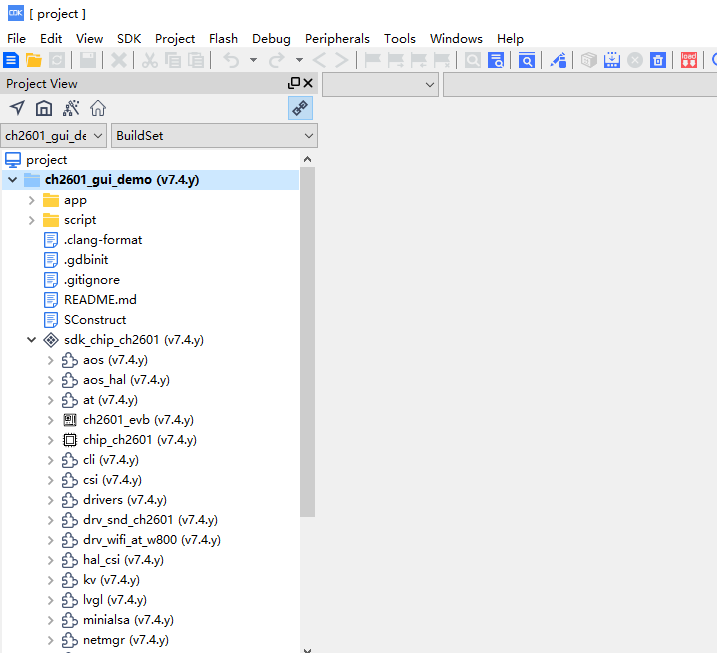
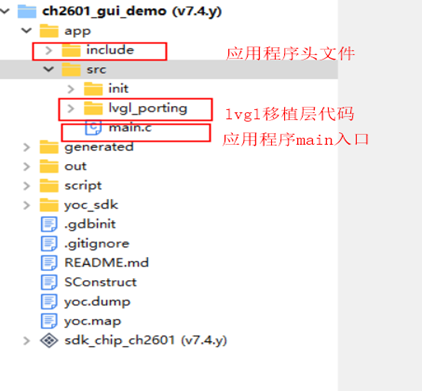
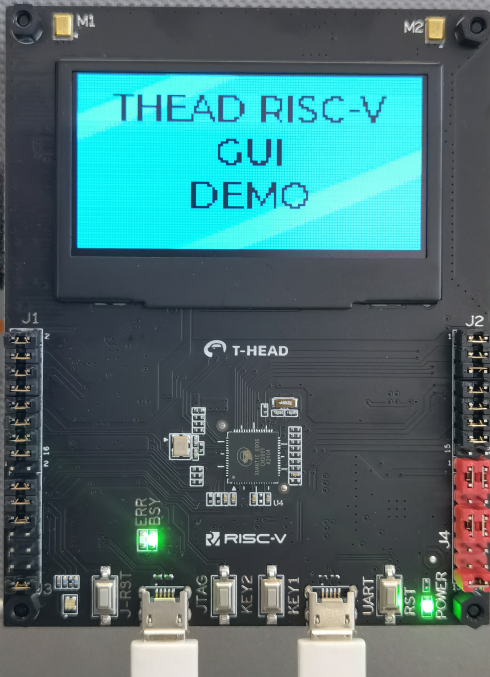












评论